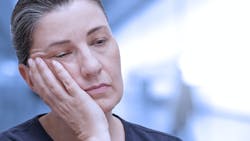How to identify dental patients at risk for sleep-disordered breathing
Sleep-disordered breathing (SDB) describes a group of conditions that adversely affect how someone breathes while they sleep. About 18 million US adults are afflicted with moderate to severe obstructive sleep apnea (OSA).1 Many of these individuals are patients we see in our dental offices and who have not been diagnosed by a physician.
Learning to recognize the signs and symptoms of SDB will help us serve patients’ needs better by improving their oral and systemic health and making referrals to health-care specialists who are trained in SDB. Dental hygienists are in a unique position to evaluate the oral cavity and airway. Identifying patients who are at an increased risk for sleep apnea can improve the quality of and even save their lives.
The most common disorders that fall under the category of SDB are OSA, central sleep apnea (CSA), mixed sleep apnea (MSA), upper-airway resistance syndrome (UARS), and obstructive sleep apnea syndrome (OSAS). For purposes of this article, OSA will be the main focal point since it’s the most common form of SDB.
OSA is an incurable condition in which an individual’s airway closes or collapses while sleeping, resulting in periods of apnea (cessation of breathing). Untreated OSA has been linked to a growing number of life-threatening health conditions, including high blood pressure, heart attack, and stroke. Early detection, testing, and treatment are vital to manage the disease, and oral health-care professionals can play an important role.
You might also be interested in
The dental hygienist’s role in screening for sleep apnea
Sleep apnea in pediatric and adolescent patients
SDB assessment
When patients come in for their hygiene appointments, it’s crucial for us to ask the right questions to assess their level of risk for OSA, which is characterized by repeated pauses in breathing during sleep, which causes oxygen deprivation. This can cause serious side effects such as excessive drowsiness through the day, headaches, mood changes (such as feelings of anxiety), disruptions in brain function, difficulty concentrating on tasks, and loss of focus.2
The cessation of breathing during sleep is episodic and patients with OSA may wake up after a full night’s rest feeling drowsy and exhausted. Another common OSA symptom is waking up multiple times during sleep but not knowing why. Recognizing these signs in your patients can help with clinical assessment.
OSA risk factors
According to Berggren et al, dental professionals seldom recognize patients who are at high risk or who have OSA.3 Part of the medical history should include a short but meticulous risk questionnaire for OSA. Some risk considerations include the individual’s age, being overweight or obese, snoring, grinding teeth while asleep, family history of OSA, hypertension, gasping for air during sleep, hypersomnia, being male, having a large neck circumference (more than 16 inches), and being older than 40.4 In addition, patients with OSA may have a difficult time initiating or maintaining sleep (insomnia).
Intraoral examination
Because clinical hygienists can view the tissues and structures in the oral cavity, they have a better opportunity and vantage point for viewing the airway. Besides screening for gum disease and oral and pharyngeal cancers, assessing the airway should further stress the importance of conducting an oral exam at every hygiene appointment. We can ask patients to open their mouths wide and say “ahhh.” If we can see the patient’s airway, we can visualize the tonsils, uvula, palatine arch, and size of the airway opening.
If the airway is narrow or any of the surrounding structures are enlarged or partially blocking the airway, document the findings in the clinical notes and discuss this with your patient. If the airway cannot be visualized, this should also be documented.
In addition to checking the airway, note if your patient has any sign of wear on their teeth. This may be an indication that their blood oxygen levels have dropped during sleep. In a desperate attempt to receive oxygen while sleeping, the body moves the lower jaw forward (grinding) in an attempt to open the airway and start breathing again.
Extraoral examination
In addition to intraoral manifestations consistent with OSA, you should also note extraoral findings that may confirm suspicions. Studies have shown that forward head posture, or hyperextension of the head, is directly related to the severity of OSA.5 Neck circumference greater than 16 inches should be documented. Note that a large neck, whether caused by visceral fat accumulation or large muscles, places additional weight on the airway during periods of atonia during sleep, contributing to airway collapse.
Craniofacial development is another aspect of the assessment to consider. Fagundes and others state that things such as increased facial height (a “long face”), a patient’s inability to easily close the lips around the teeth, a retrognathic profile, high mandible angle, and steep mandibular plane are more common in individuals with OSA than those without.6 These skeletal findings are common in people with a history of mouth breathing, which also contributes to OSA risk.
Radiographic examination
Lastly, radiographic imaging can help in assessing a patient’s risk for OSA. A growing number of dental practices have invested in cone beam computed tomography (CBCT) to provide more comprehensive care, and it can also be used in airway evaluation. A small airway width, short anterior-posterior distance, small total airway volume, small average airway area and volume, and short airway length are cause for concern during this evaluation.7 A dentist with advanced training in assessing and detecting airway abnormalities is key.
Evaluation
The information from your questionnaire and clinical findings should be reviewed to determine the level of risk for OSA. It’s the clinical team’s responsibility to use the findings to decide the next step. Some dental offices have pulse oximetry equipment that can be sent home with the patient as a next step for more screening. This technology can monitor the individual’s blood oxygen saturation while sleeping, an important component of quality sleep.
If a patient has several risk factors for OSA, the airway appears to be partially or completely blocked, or the results with a pulse oximetry screening are concerning, refer to a sleep medicine physician for polysomnography, also known as a sleep study, to diagnose OSA and other sleep disorders. If your referring dentist does not have a professional relationship with a sleep medicine physician, then an ear nose and throat specialist, neurologist, somnologist, or primary care doctor may be a resource for diagnoses and treatment.
The acknowledgment of risk factors alone does not equal responsible patient care. Discussing exam findings, explaining their potential relationship to sleep-disordered breathing, and the need for further testing is crucial in proper care. Developing collaborative relationships with local physicians and health-care providers will not only assist in the continuation of care but will also increase the patient’s trust in you as their oral health-care provider.
Sleep-disordered breathing, particularly OSA, is a chronic, life-threatening condition that is largely undetected and underdiagnosed in American adults. Dental hygienists have the clinical knowledge needed to perform early detection screenings and determine if their patient is at risk for OSA. After evaluating exam findings, patients with concerns should be referred to the appropriate health-care provider for further testing and treatment. Within a matter of minutes, a dental hygienist can help save a life, which is knowledge that will help us sleep a little easier.
Editor's note: This article appeared in the November-December 2023 print edition of RDH magazine. Dental hygienists in North America are eligible for a complimentary print subscription. Sign up here.
References
- Williams C. Treating sleep apnea made easier: upper airway stimulation therapy. Mayo Clinic Health System. June 23, 2023. https://www.mayoclinichealthsystem.org/hometown-health/speaking-of-health/upper-airway-stimulation-therapy
- Sleep apnea: What it is, causes, symptoms and treatment. Cleveland Clinic. November 15, 2022. https://my.clevelandclinic.org/health/diseases/8718-sleep-apnea#symptoms-and-causes
- Berggren K, Broström A, Firestone A, Wright B, Josefsson E, Lindmark U. Oral health problems linked to obstructive sleep apnea are not always recognized within dental care-as described by dental professionals. Clin Experiment Dent Res. 2021;8(1):84-95. doi:10.1002/cre2.517
- Feltner C, Wallace IF, Aymes S, et al. Screening for obstructive sleep apnea in adults: an evidence review for the US preventive services task force. National Library of Medicine. November 2022. https://www.ncbi.nlm.nih.gov/books/NBK588761/#ch1.s4
- Piccin CF, Pozzebon D, Scapini F, Corrêa EC. Craniocervical posture in patients with obstructive sleep apnea. Int Arch Otorhinolaryngol. 2016;20(3):189-195. doi:10.1055/s-0036-1584295
- Fagundes NCF, Gianoni-Capenakas S, Heo G, Flores-Mir C. Craniofacial features in children with obstructive sleep apnea: a systematic review and meta-analysis. J Clin Sleep Med. 2022;18(7):1865-1875. doi:10.5664/jcsm.9904
- Buchanan A, Cohen R, Looney S, Kalathingal S, De Rossi S. Cone-beam CT analysis of patients with obstructive sleep apnea compared to normal controls. Imaging Sci Dent. 2016;46(1):8-16. doi:10.5624/isd.2016.46.1.9
About the Author

Vilma Cordero, MHSc, BASDH, RDH
Vilma Cordero, MHSc, BASDH, RDH, is a licensed hygienist in the states of Florida and North Carolina with over 13 years of dental clinical experience. She holds a master of health science in health-care administration and a bachelor of applied science in dental hygiene. Vilma is the owner/operator of Practical Hygiene Solutions, a dental coaching and consulting company in North Carolina. She is a member of the American Dental Hygienists' Association, American Dental Education Association, and the American Academy for Oral System Health.

Bethany Montoya, MBA, RDH
Bethany Montoya, MBA, RDH, is a practicing dental hygienist, educator, industry key opinion leader, and editorial director of DentistryIQ’s Clinical Insights newsletter. She has a passion for advancing modern disease prevention. She specializes in exploring the intersection of clinical practice, professional growth, and innovation within oral health care. Through her writing, she aims to educate, inspire, and spark meaningful dialogue in the dental community. She can be reached at [email protected].
